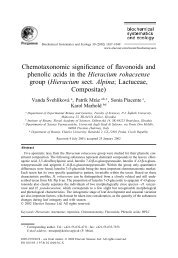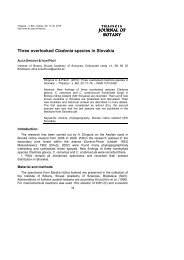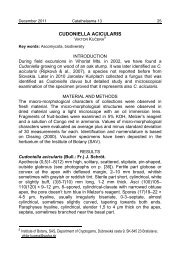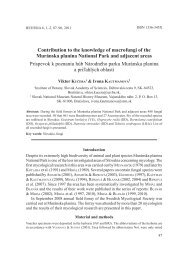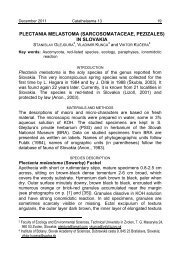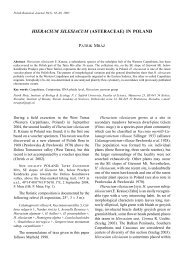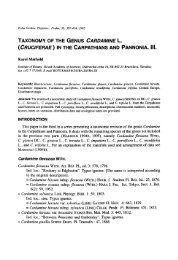Typification of the Linnaean names of the genus - institute of botany ...
Typification of the Linnaean names of the genus - institute of botany ...
Typification of the Linnaean names of the genus - institute of botany ...
You also want an ePaper? Increase the reach of your titles
YUMPU automatically turns print PDFs into web optimized ePapers that Google loves.
118 K. MARHOLD<br />
Linnaeus. The illustration roughly corresponds to C. chelidonia in <strong>the</strong> current sense,<br />
but it lacks auriculate bases to <strong>the</strong> petioles, an important distinguishing character. No<br />
herbarium specimen upon which <strong>the</strong> illustration is (or might be) based could be<br />
traced.<br />
Cardamine chelidonia as used in recent literature (Jones & Akeroyd, 1993; Verlaque<br />
et al., 1993; Jalas & Suominen, 1994) is native to Italy, Corsica and Croatia. Apart<br />
from <strong>the</strong> morphological variability reflected in two varieties described within this<br />
species (var. brutia Porta from Calabria and var. kitaibelii Borbás from Croatia), <strong>the</strong>re<br />
is variation in chromosome numbers (2n = 16 by Manton (1932) from <strong>the</strong> material<br />
from <strong>the</strong> botanical garden, 2n = 32 from <strong>the</strong> Czech Republic (where it is introduced)<br />
by Hrouda (1992: 110) and recently 2n = c.64 by Verlaque et al. (1993) from N.<br />
Corse). Therefore it is desirable to select a lectotype which can be critically identified<br />
for <strong>the</strong> purpose <strong>of</strong> <strong>the</strong> precise application <strong>of</strong> <strong>the</strong> name. The only illustration<br />
corresponding to <strong>the</strong> present use <strong>of</strong> <strong>the</strong> name C. chelidonia (e.g. Barrelier’s one) could<br />
not be so identified and, moreover, its selection as a lectotype might be precluded by<br />
<strong>the</strong> Art. 8.3 <strong>of</strong> <strong>the</strong> ICBN, which, in some interpretations, does not permit <strong>the</strong><br />
selection <strong>of</strong> <strong>the</strong> illustration as a lectotype in <strong>the</strong> case when any relevant herbarium<br />
specimen is available. Therefore, in order to avoid undesirable name change, a new<br />
conserved type will be proposed to preserve <strong>the</strong> current use <strong>of</strong> <strong>the</strong> name.<br />
Cardamine graeca L., Species plantarum: 655, 1753. - LT (designated here): L - herbarium<br />
van Royen, no. 901.220–60, restricted to <strong>the</strong> flowering plant in <strong>the</strong> lower part <strong>of</strong> <strong>the</strong><br />
sheet (Fig. 1).<br />
The protologue (Linnaeus, 1753: 655) has <strong>the</strong> following elements:<br />
9. CARDAMINE foliis pinnatis: foliolis palmatis aequalibus<br />
petiolatis. Roy. lugdb. 345. Hort. ups. 188.<br />
Nasturtium montanum nanum, rotundo thalictri folio, cyrenaeum.<br />
Bocc. mus. 2. p. 171. t. 166.<br />
Sio minimo prosperi alpini affinis, siliculis latis. Bocc. sic. 84,<br />
t. 44. f. 2.<br />
Habitat in Sicilia, Corsica, insulis Graeciae. �<br />
The diagnostic phrase-name is referred directly to van Royen’s Florae leydensis<br />
prodromus (1740) and to Linnaeus’s Hortus upsaliensis (1748), where it appears in a<br />
slightly different form.<br />
The specimen in <strong>the</strong> <strong>Linnaean</strong> herbarium in London (LINN), no. 835.12 with<br />
Linnaeus’s inscription “Cardamine graeca” does not bear <strong>the</strong> number from Species<br />
plantarum and thus it was most probably added to Linnaeus’s herbarium after 1753<br />
(cf. Jarvis, 1992: 506).<br />
There is ano<strong>the</strong>r specimen <strong>of</strong> C. graeca in <strong>the</strong> van Royen herbarium in Leiden (L,<br />
no. 901.220–60), bearing <strong>the</strong> full reference to <strong>the</strong> Prodromus. Stearn (1957: 105)<br />
considered <strong>the</strong> herbarium <strong>of</strong> Adriaan van Royen as “indirectly relevant to Linnaeus’s<br />
work”. However, Wijnands (1983) is <strong>of</strong> <strong>the</strong> opinion that <strong>the</strong> specimens with reference<br />
to Adriaan van Royen’s Prodromus are in many cases relevant for <strong>the</strong> typification <strong>of</strong><br />
<strong>Linnaean</strong> <strong>names</strong>. According to him <strong>the</strong>re is every reason to assume that Linnaeus<br />
contributed substantially to <strong>the</strong> Prodromus and that van Royen’s herbarium was at his<br />
disposal. Following that argument <strong>the</strong> above mentioned specimen <strong>of</strong> C. graeca seems<br />
to be fully eligible as a lectotype <strong>of</strong> this name.<br />
The second phrase name, cited in <strong>the</strong> protologue, is cited from Boccone’s Museo



